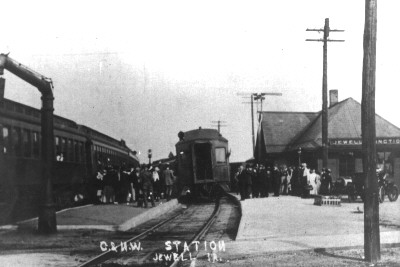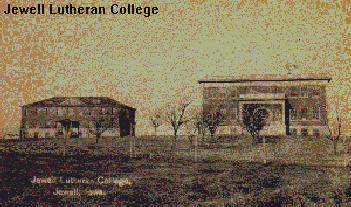Jewell Junction, Iowa - founded in 1880
By Martin E. Nass
Transcribed for the IAGenWeb Project by Janelle Martin, with permission of Martin "Ed" Nass.
Jewell Junction Depot.

Picture taken in 1912
In 1880 the Toledo & Northwestern Railroad came west and formed a junction with
the north-south line that was rebuilt from the narrow gauge Des Moines and Minnesota
Railroad that formerly terminated at Callanan. The portion of the line to Callanan
was abandoned and rerouted to Jewell Junction. The Toledo & Northwestern soon
became the Chicago & Northwestern Railroad.
The town of Jewell Junction was laid out at the junction of the two railroad lines,
and was named for David T. Jewell. It was created in Sec. 28-87-24 by the real estate
division of the railroad, the Western Town Lot Company. This same company platted
Ellsworth, Randall, Stanhope, Stratford and Kamrar.
The east-west streets in the orginal plat were First (a curved street), Second, Third,
Fourth, and Fifth Streets. The north-south streets were Lyon, Main, Rienhart, and
Idaho Streets. Main Street was later changed to Jewell Street. The name of the town
was eventually changed to Jewell because the residents grew to dislike the "Junction"
reference as the town prospered.
The post office was established on December 27, 1880. The post office was located
about 40 rods south of the depot. Mrs. Laura E. Cooper served as the first postmaster.
John Foster served as the first rural mail carrier starting in 1903. The five digit
zip code for Jewell was introduced on July 1, 1963.
The Jewell Telephone Company was started in 1902 by about 30 businessmen. Frank Snyder
served as president. Within three years the number of subscribers had grown to 125.
In 1905 the Jewell and Ellsworth Telephone Company was created.

One of the store buildings was moved from Callanan during the winter of 1881-1882.
The reason buildings were moved in the winter was because they could be more easily
put on skids and pulled by teams on the frozen ground. This was true of so many buildings
that were moved from Lakin's Grove, Callanan, Hook's Point, and other towns that
failed to attract a railroad. This building was placed along Main Steet. The first
school was held in the rented back room with William Anderson serving as teacher.
The next year a school district was organized and the school was moved to a different
building south of the railroad tracks. Anderson was the only teacher for one year.
In 1883 Howard Smith was added to the school staff. By 1890 a whole block was purchased
and a two-story brick structure was built. Two years later a four-year high school
program was added. In 1905 an addition was constructed on both ends of the school.
This building took care of the school needs for another 20 years.

Jewell had the first
college in Hamilton County. It was established in Jewell in 1893 by the Jewell Lutheran
College Association. The majority of the members of this association were Scandanavian
Lutherans from the surrounding counties. In 1897 it became apparent that larger support
was needed for the school so the college and all of its property was transferred
to the Iowa District of the Hague Synod, under whose management the college grew
and progressed.
In 1903 the main college building burned killing two students: Julius Peterson and
Burton Millang. In February of 1904 it was decided to rebuild two new buildings.
One was Main Hall and the other was a ladies dormitory. The college was discontinued
in 1925 and the property was purchased by the school district.
The South Hamilton Community School District was created in September, 1958, beginning
operation on July 1, 1959. A reorganization in 1962 combined the districts of Randall,
Ellsworth, Stanhope with Jewell. Several years and several votes later a central
high school building won approval. This school was located near the site of the former
Jewell Lutheran College, and was completed in 1968.
The population of Jewell in the 1990 census was 1,106 which makes Jewell the second
largest town in our county. The town slogan is "A Gem in a Friendly Setting."
|